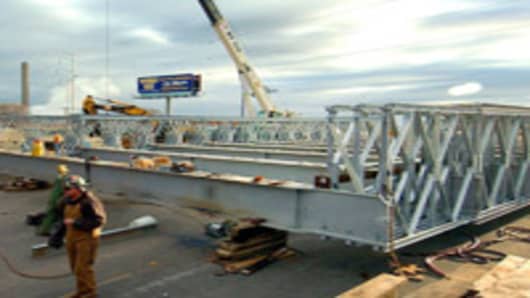The prospect of significant infrastructure spending was welcomed by business and investors.
“Funding for these infrastructure projects is not business as usual,” says Robyn Boerstling, director of transportation and infrastructure policy at the National Association of Manufacturers. “The needs are so great,” because cash-strapped states have been deferring projects, new or maintenance oriented.
Booerstling and others says the plan will lead to new jobs for the beaten-down construction industry and parts of its supply chain, as well as less obvious beneficiaries, such as engine and equipment manufacturers.
The push for stimulus measures with a job creation component also happens to coincide with a rapidly deteriorating job market, as evidenced by the stunningly large decline in November payrolls announced last Friday.
Irons say such spending will put an immediate “dent in unemployment” and because it is expected to play out for a couple years “will provide enough business to lead to greater employment.”
The American Association of State Highway and Transportation Officials, for instance, recently estimated that $18 billion worth of funds covering 3,000 ready-to-go projects would generate 630,000 jobs.
Another 250,000 jobs would result from $20 billion in green school construction and renovation, according to an analysis by the the Economic Policy Institute.
Other economists were generally optimistic about the positive impact, especially given the large needs of states and cities, some of which have constitutional constraints on deficit spending.
“This is an instance where crisis might present an opportunity,” says Paul Wachtel of NYU’s Sterns School of Business. The improvements could have long-term benefits for the US economy.”
What The Critics Say
Infrastructure spending, however, is hardly without risk and certainly not immune to criticism and skepticism.
In general, economists point to a low rate of return on investment and the potential for corruption and waste.
“I have serious reservations that government spending is stimulus, period,” says Dan Mitchell of the Cato Institute and former Capitol Hill economist. “What would that have been financed if the money was left for other purposes. It didn't work for [presidents Herbert] Hoover or [Franklin Delano] Roosevelt in the ‘30s and it didn’t work for Japan in the ‘90s.”
Though critics admit repair-based projects are preferable to “bridge-to-nowhere” ones, the allocation of money is often based on political factors, not smart economics.
Critics point to expensive mass transit systems in Los Angeles, and even Washington DC and the wide, sometimes irrational dispersal of funding for security measures after the 9/11 terror attacks.
More practically, opponents cite the time lag between the allocation of funds and the actual start of work, which in some cases is long enough that the need no longer exists and any benefit is marginal, if not superfluous.
In addition, companies sometimes find it preferable to pay overtime to existing workers rather than add new ones.
“My main concern is the cost of doing this will probably be double what the price tag will be,” says Steve Hanke of Johns Hopkins University. “Its going to cost a lot more than advertised.”
For all the debate about the pros and cons of infrastructure spending as a fiscal stimulus tool, there are few recent examples on a federal level. And don’t look to the Interstate Highway System as any guide.
Then President Eisenhower championed the project during a time of almost unparalleled prosperity in the 1950s. The highway system was conceived as a 12-year, $25 billion project. By general accounts, it wound up costing $114 billion over three and a half decades.




